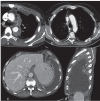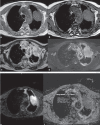Diagnostic Imaging and workup of Malignant Pleural Mesothelioma
- PMID: 28845826
- PMCID: PMC6166151
- DOI: 10.23750/abm.v88i2.5558
Diagnostic Imaging and workup of Malignant Pleural Mesothelioma
Abstract
Malignant pleural mesothelioma is the most frequent primary neoplasm of the pleura and its incidence is still increasing.This tumor has a strong association with exposure to occupational or environmental asbestos, often after a long latent period of 30-40 years.Plain chest radiography (CXR) is usually the first-line radiologic examination, but the radiographic findings are nonspecific due to its limited contrast resolution and they need to be complemented by other imaging modalities such as computed tomography (CT), magnetic resonance Imaging (MRI), Positron emission tomography-computed tomography (PET-CT) and ultrasound (US).The aim of this paper is to describe the imaging features of this malignancy, underlining the peculiarity of CXR, CT, MRI, PET-CT and US and also focusing on diagnostic workup, based on the literature evidence and according to our experience.
Keywords: Malignant Pleural Mesothelioma, Computed Tomography, Video assisted Thoracic Surgery, Magnetic Resonance Imaging, Thoracic Ultrasound, Positron-emission tomography.
Figures







References
-
- Nickell LT Jr, Lichtenberger JP 3rd, Khorashadi L, Abbott GF, Carter BW. Multimodality imaging for characterization, classification, and staging of malignant pleural mesothelioma. Radiographics. 2014 Oct;34(6):1692–706. doi: 10.1148/rg.346130089. - PubMed
-
- Rusch VW. Diffuse malignant mesothelioma. General thoracic surgery. In: Shields TW, LoCicero J III, Reed CE, Feins RH, editors. Philadelphia: Wolters Kluwer/Lippincott Williams & Wilkins; 2009. pp. 847–59.
-
- Boutin C, Rey F. Thoracoscopy in pleural malignant mesothelioma: a prospective study of 188 consecutive patients. Part 1: diagnosis. Cancer. 1993;72(2):389–93. - PubMed
-
- Flores RM, et al. The impact of lymph node station on survival in 348 patients with surgically resected malignant pleural mesothelioma: implications for revision of the American Joint Committee on Cancer staging system. J Thorac Cardiovasc Surg. 2008;136(3):605–10. - PubMed
Publication types
MeSH terms
LinkOut - more resources
Full Text Sources
Medical
